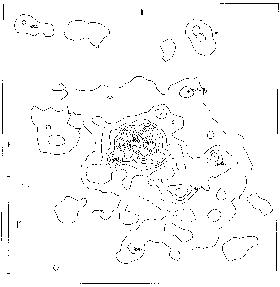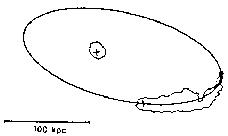


7.2. Subclusters in the Core
The existence of substructure within the core of Coma was first suggested by Bahcall [10] in the 70's. She observed an anisotropic distribution of the bright galaxies in the Coma core, along the E-W direction and suggested that:
...the observed anisotropy of the bright galaxies could arise from subclustering around each of the two supergiants at the center of the cluster.
She also noticed that subclustering was stronger around NGC 4874, the less bright of the two central dominant galaxies. Recent results [16], [27] confirm her early suggestions.
One year later, Rood [114] pointed out "a possible tendency for S0 galaxies to surround NGC 4874 and ellipticals to surround NGC 4889". To my knowledge, there has been no confirmation of this effect. The recent morphological catalogue of Andreon et al. [9] is best suited for the investigation of this issue (see also Andreon, these proceedings).
In January 1979 two papers appeared, both fundamental for the understanding of subclustering in the Coma core, one from Quintana [107], the other from Struble.
Quintana noticed a narrow density peak centered very close to NGC 4874, and suggested it "may indicate the presence of a dynamically separated subunit". Struble observed that the velocity dispersion of three clusters (among which Coma) decreases when only the core region is selected. This was interpreted as evidence that
...the most massive galaxies in the core have "captured" less massive galaxies as satellites and formed isolated subsystems
Struble also mentioned dynamical friction as a possible alternative explanation (see Section 6.3).
Valtonen & Byrd's binary model for the Coma cluster (see Section 3.3) was motivated by the growing evidence of the existence of subclusters in the Coma core. This suggests that by the late 70's the idea of a complex structure for the Coma core was already taking root in the astrophysical community. In 1984, Baier published the first paper specifically devoted to the issue of subclustering in Coma. He reviewed the evidence for subclustering in Coma, partly coming from the presence of the SW-group (see Section 7.1), and partly from the "double character of the central cluster region".

|
Figure 15. Isocontours of galaxy number densities in the Coma cluster; the brightest Coma galaxies are listed. The vertical line on the left indicates a scale of 1° - from Mellier et al. |
The evidence for subclustering in the Coma core was growing fast. Perea et al. first identified the two central groups in velocity space, and found mean velocities of 6431 km/s and 7072 km/s, and velocity dispersions of 220 km/s and 137 km/s for the groups centered around NGC 4889 and NGC 4874, respectively. Their results anticipated those of Fitchett & Webster and Mellier et al., both qualitatively and quantitatively (Mellier et al.'s estimates of the velocity moments of the two central groups differ by less than 10 % from Perea et al.'s), yet Perea et al.'s paper received much less attention than the other two (11) (was the word "taxonomical" in the title of their paper weird enough to discourage potential readers?).
Fitchett & Webster were possibly the first to use the word "substructure" in the title of a paper on Coma. Using the Lee-method, they separated galaxy members of the NGC 4889 group from galaxy members of the NGC 4874 group, and proposed a circular-orbit dynamical model for the two central subgroups (reminiscent of Valtonen & Byrd's model). They mentioned two possible origins for the substructures in the core:
Nowadays, a third interpretation [27] has made his way:
The difference between the NGC 4874 velocity and the mean cluster velocity (as well as its radio-morphology, see below), still gives some credit to Fitchett & Webster's scenario n.2 (see Biviano et al. [16]).
Of the 9 density peaks identified by Mellier et al. in Coma,
two of them are in the cluster core (see
Fig. 15), centered on
NGC 4889 and NGC 4874, that are surrounded by a
population of satellite galaxies. In Mellier et al.'s scenario, these
subclusters exist as independent groups before infalling into the cluster.
At the time of infall, they have already passed
through a mass-segregation instability-phase.
During the infall, tidal effects strip the groups of their
less bound low-mass galaxies, while the high-mass galaxies in the group
cores, resist longer. Support from their scenario came recently
from Biviano et al.
[16], who showed
that faint galaxies (b  17)
do not cluster around the giant
galaxies, at variance with bright galaxies.
17)
do not cluster around the giant
galaxies, at variance with bright galaxies.
Mellier et al. estimated masses of
6 × 1013
M and
5 × 1013
M
and
5 × 1013
M , for the
groups around NGC 4874 and NGC 4889, respectively.
Their estimates have since been confirmed (to within 50 %) by later works
(see below).
, for the
groups around NGC 4874 and NGC 4889, respectively.
Their estimates have since been confirmed (to within 50 %) by later works
(see below).
Some years later, Escalera et al.'s wavelet analysis
detected the two central substructures with 99.9 % significance. The
velocity dispersions they derived for the two subclusters are rather high,
and more similar to the values found by Fitchett & Webster than to
those found by Perea et al. and Mellier et al. Probably, contamination by
cluster (and not group) members, affected their
 v-estimates.
v-estimates.
Non-optical wavelength observations also provided evidence for for a complex structure of the Coma core. In 1985, Feretti & Giovannini [45]'s radio observations of NGC 4874 showed that this galaxy was a Wide-Angle-Tail radio-source. This morphology is indicative of motion of NGC 4874 through the surrounding IC gas, i.e. the galaxy is not at rest at the bottom of the cluster potential (or the IC gas has a bulk velocity).

|
Figure 16. The orbit of NGC 4869 around NGC 4874 as derived by Feretti et al. The radio-morphologies of the two galaxies are sketched. |
Based on the radio morphology of another galaxy in the Coma core, NGC 4869,
whose radio-emission was first mapped by Willson,
Feretti et al. [44]
obtained the orbit of this galaxy around NGC 4874
(see Fig. 16), and estimated the mass of the couple
in
5 × 1013
M (similar to
Mellier et al.'s estimate).
(similar to
Mellier et al.'s estimate).
Last came the X-ray observations. In 1993 Davis & Mushotzky [33] and White et al. detected substructures in the X-ray image of Coma. In particular, Davis & Mushotzky 12 used the Einstein data to show the existence of excess X-ray emission from NGC 4874, and a region 2.5' west of NGC 4889. The higher resolution ROSAT data allowed White et al. to confirm the former detection, but not the latter. Other irregularities in the X-ray surface brightness were found, all associated with bright galaxies, NGC 4889, NGC 4911, NGC 4848 and NGC 4839 (this last already mentioned in Section 7.1). The groups detected by Mellier et al. in the optical were showing up in X-rays!
White et al. also detected a secondary peak of emission, half-way between the two central dominant galaxies, which they interpreted as gas stripped off NGC 4889. Biviano et al. [16] found an intriguing positional coincidence of this X-ray peak and the number density peak of faint Coma galaxies. They suggested that White et al.'s secondary peak is in fact emission from the main body of the Coma cluster, masked by the superposition of several subclusters.
Finally, Vikhlinin et al.
[147]
applied the wavelet analysis to the ROSAT image of Coma,
disentangling the emission of the two central groups
from that of the cluster. The optical
[42]
and X-ray wavelet-images
looked remarkably similar. Under quite general assumptions, they
were able to estimate the masses of the NGC 4874 and NGC 4889 subclusters in
3.4 × 1013
M and 2.6
× 1013
M
and 2.6
× 1013
M , again quite
close to the original Mellier et al.'s estimates.
, again quite
close to the original Mellier et al.'s estimates.
11 The NASA Astrophysics Data
System lists only three papers making reference to Perea et al.,
as compared to 75 papers referring to Fitchett & Webster and 43 papers to
Mellier et al.
Back
12 When Davis & Mushotzky first found
evidence for substructure in the core of Coma in the X-ray, this
was known in the optical since 20 years
[10].
In perspective, the following statement of them sounds
auto-ironic:
The ability of the x-ray observations to locate this
structure when both
galaxy counts and radial velocity information were inconclusive
[...] is an indication of the power of searching for substructure in
x-rays.
Back